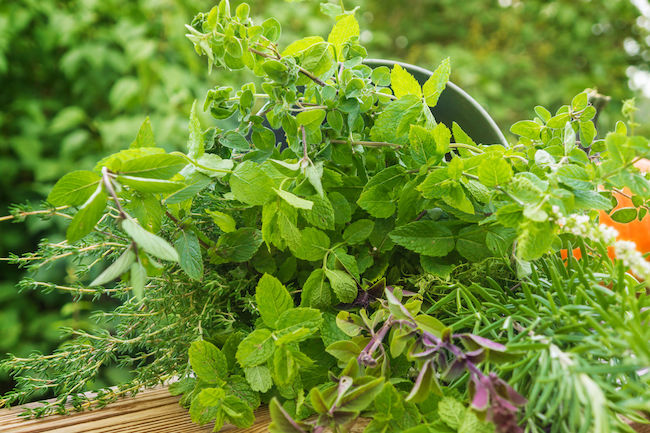
People have consumed herbal teas for thousands of years. You can find many varieties at most grocery stores, and scientists are studying the benefits of consuming herbs. Unfortunately, grocery store teas can be old, making them less effective and overpriced. While buying local is an easy solution, not everyone lives near a farm that creates herbal products, like 2019 grantee DoLittle Pastures. Fortunately, growing an herbal tea garden in your own backyard can be a simple and rewarding summer project. To begin, consider trying these easy-to-grow herbs, perfect for making your own inexpensive, healthy teas.
Herbs to Grow
Lemon Balm
While lemon balm’s bright flavor is reason enough to love this herb, studies have shown it’s effective at improving mood and reducing anxiety. It can also help calm an upset stomach, which sometimes goes hand in hand with anxiety. In the garden, it’s super easy to grow, though as a member of the mint family, it tends to spread on its own, which is something to consider when choosing a planting site.
Echinacea
Also called coneflower, echinacea is a wonderful perennial herb that can help support your body’s immune system. The roots, seeds, leaves, and flowers can all be used to prevent and fight off a cold or the flu. Once established, it’s easy to grow and will sometimes self-seed. If you’re starting from seed, it’s important to place your seeds in the refrigerator for at least one week prior to planting. This process, called cold stratification, mimics winter conditions and will improve your germination rates.
Chamomile
The perfect bedtime tea, chamomile is mostly known for its ability to promote relaxation and sleep. Chamomile tea is also an excellent choice to promote digestion and is great for families to grow because it’s safe for most young children. It’s fairly easy to start from seed and will often self-seed each year, but it’s important to note that the seeds need light to germinate, so you should tamp them gently into the surface of the soil rather than bury them.
Mint
Mint may be the easiest herb to grow. Used as an herbal tea, the leaves can be calming and uplifting. Some people find that mint tea is an effective remedy for digestive issues, such as nausea, bloating, and gas. It’s also perfect for a refreshing iced tea on a hot summer’s day.
Lavender
Like chamomile, lavender can be used to help you relax and sleep soundly. Some studies also show that it can improve your mood and cognitive function. Lavender contains tannins, so it’s too strong and astringent to make as a tea by itself, but it’s excellent when mixed with other calming herbs, like chamomile or lemon balm. You can also pair it with lemonade for a tasty and healthful summer drink. Lavender can be grown from seed or is available at many plant nurseries. Different varieties of lavender flourish in a wide range of growing zones.
Monarda
There are many flowers in the Monarda genus, and all of them can be used medicinally and make a delicious tea. Monarda flowers have antimicrobial, antibacterial, and antifungal properties, making them an excellent tea to help fight off colds, the flu, and infections. They’re also great for attracting butterflies, bees, and hummingbirds to your garden and are often called bee balm.
Anise Hyssop
Anise hyssop has been used medicinally for centuries in treating a variety of ailments. Recently, it’s been studied for its antiviral properties, as well as its use as a decongestant. It can easily be grown from seed, and as a tea it offers a delicious, sweet, licorice-like flavor.
Catnip
It’s not just for cats! Catnip is another easy-to-grow and helpful member of the mint family. Tasty tea made from its leaves can help treat insomnia, constipation, and stomachache. It will self-seed, but make sure you keep cats from disturbing it until it’s well established.
Making Tea
It may not seem like it, but there’s actually an art to making the perfect cup of herbal tea. To make tea, use about three teaspoons of fresh herbs or one teaspoon of dry herbs per 8 oz. cup. You can place herbs in a tea ball or infuser, or pour your tea through a fine mesh strainer once it has steeped. You’ll want to place the herbs in your mug, pour boiling water over them, and let them steep for about five minutes. While they’re steeping, place a plate or lid loosely over your mug to hold in the steam. This will make your tea more flavorful and potent. For iced teas, you can transfer the steeped tea into a pitcher and place it in the refrigerator once it has cooled. You can also freeze herbs in ice cubes to add a fun touch to summertime iced teas.
Drying Herbs
During the summer months, it’s wonderful to be able to step into your backyard and clip some herbs to make fresh tea. If you’d like to keep enjoying your herbal tea during the winter, you’re going to need to dry some of your harvests. Depending on the herb you’re preserving, you can use a dehydrator or just air-dry your herbs. It’s best to harvest herbs in the morning, before the midday heat. If needed, give herbs a quick rinse. If you’re using a dehydrator, you’ll want to use a low temperature, and many dehydrators have an herb setting. Some herbs, like mint, can be easily dried without the use of a dehydrator. Simply make bundles and hang them upside down in a cool, dry place. You can place a paper bag over the bundles to prevent dust from getting on them. When they’re completely dry, store your herbs in airtight containers.
If you have room to expand, consider planting some of these herbs in your garden this summer. Just a little extra work and space can provide you with tons of healthy, affordable, and delicious herbal tea blends that you can drink year-round.
Jordan Charbonneau is an organic farmer and writer from West Virginia. She holds degrees in ecology and environmental humanities from Sterling College in Vermont.




